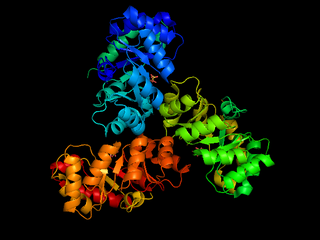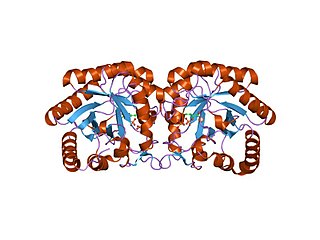In biochemistry, a lyase is an enzyme that catalyzes the breaking of various chemical bonds by means other than hydrolysis and oxidation, often forming a new double bond or a new ring structure. The reverse reaction is also possible. For example, an enzyme that catalyzed this reaction would be a lyase:

Sphingolipids are a class of lipids containing a backbone of sphingoid bases, which are a set of aliphatic amino alcohols that includes sphingosine. They were discovered in brain extracts in the 1870s and were named after the mythological sphinx because of their enigmatic nature. These compounds play important roles in signal transduction and cell recognition. Sphingolipidoses, or disorders of sphingolipid metabolism, have particular impact on neural tissue. A sphingolipid with a terminal hydroxyl group is a ceramide. Other common groups bonded to the terminal oxygen atom include phosphocholine, yielding a sphingomyelin, and various sugar monomers or dimers, yielding cerebrosides and globosides, respectively. Cerebrosides and globosides are collectively known as glycosphingolipids.

Sphingosine kinase (SphK) is a conserved lipid kinase that catalyzes formation sphingosine-1-phosphate (S1P) from the precursor sphingolipid sphingosine. Sphingolipid metabolites, such as ceramide, sphingosine and sphingosine-1-phosphate, are lipid second messengers involved in diverse cellular processes. There are two forms of SphK, SphK1 and SphK2. SphK1 is found in the cytosol of eukaryotic cells, and migrates to the plasma membrane upon activation. SphK2 is localized to the nucleus.
The enzyme 2-dehydro-3-deoxy-6-phosphogalactonate aldolase catalyzes the chemical reaction
The enzyme 2-dehydro-3-deoxy-L-pentonate aldolase catalyzes the chemical reaction

The enzyme 2-dehydro-3-deoxy-phosphogluconate aldolase, commonly known as KDPG aldolase, catalyzes the chemical reaction
The enzyme 5-dehydro-2-deoxyphosphogluconate aldolase catalyzes the chemical reaction
The enzyme deoxyribose-phosphate aldolase catalyzes the reversible chemical reaction
The enzyme indole-3-glycerol-phosphate lyase catalyzes the chemical reaction
The enzyme ketotetrose-phosphate aldolase catalyzes the chemical reaction
The enzyme L-fuculose-phosphate aldolase (EC 4.1.2.17) catalyzes the chemical reaction

The enzyme N-acetylneuraminate lyase catalyzes the chemical reaction
The enzyme phenylserine aldolase catalyzes the chemical reaction
The enzyme rhamnulose-1-phosphate aldolase (EC 4.1.2.19) catalyzes the chemical reaction
The enzyme tagatose-bisphosphate aldolase catalyzes the chemical reaction

The enzyme threonine aldolase is an enzyme that catalyzes the chemical reaction
The enzyme ethanolamine-phosphate phospho-lyase (EC 4.2.3.2) catalyzes the chemical reaction

3-Deoxy-D-arabinoheptulosonate 7-phosphate (DAHP) synthase is the first enzyme in a series of metabolic reactions known as the shikimate pathway, which is responsible for the biosynthesis of the amino acids phenylalanine, tyrosine, and tryptophan. Since it is the first enzyme in the shikimate pathway, it controls the amount of carbon entering the pathway. Enzyme inhibition is the primary method of regulating the amount of carbon entering the pathway. Forms of this enzyme differ between organisms, but can be considered DAHP synthase based upon the reaction that is catalyzed by this enzyme.






